Harvesting fruits is a rewarding culmination of months of nurturing and care in the garden or orchard. To ensure the best flavor and quality, it’s essential to harvest fruits at the right time using proper techniques. From timing to techniques and taste, here’s everything you need to know about harvesting fruits:
1. Timing is Key:
Timing is crucial when it comes to harvesting fruits. Each type of fruit has its own optimal harvesting window, typically determined by factors such as color, size, firmness, and sweetness. Harvesting fruits too early can result in underripe and flavorless produce, while waiting too long can lead to overripeness and spoilage. It’s essential to monitor fruits closely and harvest them at their peak of ripeness for the best flavor and quality.
2. Visual Cues:
Visual cues are often the most reliable indicators of fruit ripeness. Pay attention to changes in color, texture, and size as fruits ripen. For example, many fruits, such as apples and pears, develop their characteristic color and firmness when ripe. Others, like berries and stone fruits, may soften slightly and develop a deeper hue as they ripen. Regularly inspect fruits for these visual cues and harvest them when they exhibit signs of maturity.
3. Texture and Firmness:
Texture and firmness are important factors to consider when harvesting fruits. While some fruits, like apples and pears, should be firm and crisp when harvested, others, such as peaches and berries, are best picked when they yield slightly to gentle pressure. Avoid harvesting fruits that are excessively soft or mushy, as they may be overripe and prone to spoilage.
4. Stem vs. Branch Harvesting:
The method of harvesting varies depending on the type of fruit and its growth habit. For fruits that grow on stems or branches, such as apples, pears, and citrus, it’s best to use a twisting motion to gently detach the fruit from the plant. Avoid pulling or yanking fruits, as this can damage the plant and affect future growth. For fruits that grow on vines or bushes, such as berries and grapes, simply pluck them from the plant with your fingers, being careful not to crush or bruise the fruit.
5. Taste Test:
When in doubt, perform a taste test to determine if fruits are ready for harvest. Sampling a small portion of the fruit can provide valuable insight into its flavor, sweetness, and ripeness. If the fruit tastes pleasantly sweet and flavorful, it’s likely ready to be harvested. However, if it tastes underripe or lacks flavor, it may need more time to mature on the plant.
6. Storage Considerations:
After harvesting, handle fruits with care to avoid bruising or damage. Store fruits in a cool, dry place away from direct sunlight to prolong their shelf life and maintain their quality. Some fruits, such as apples and pears, benefit from cold storage to slow down the ripening process and extend their freshness. Others, like berries and stone fruits, are best enjoyed fresh and should be consumed promptly or preserved through freezing, canning, or drying.
7. Enjoy the Fruits of Your Labor:
Finally, take the time to savor the fruits of your labor. There’s nothing quite like the satisfaction of harvesting ripe, flavorful fruits from your own garden or orchard. Whether enjoyed fresh off the tree or incorporated into delicious recipes, homegrown fruits offer a taste of nature’s bounty and the joy of a successful harvest.
Harvesting fruits involves careful timing, attention to detail, and appreciation for nature’s rhythms. By monitoring visual cues, testing for ripeness, and using proper harvesting techniques, you can enjoy the freshest, most flavorful fruits from your garden or orchard. So roll up your sleeves, head out to the garden, and savor the sweet rewards of your hard work and patience.
Join 'Farmers Mag' WhatsApp Channel
Get the latest Farming news and tips delivered straight to your WhatsApp
CLICK HERE TO JOIN






